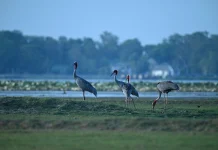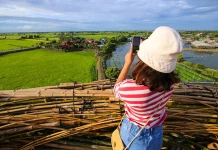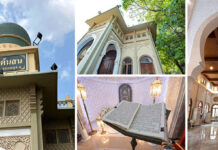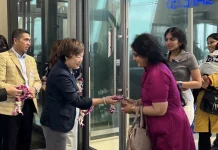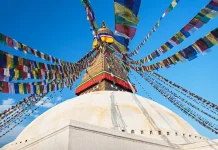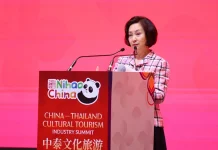Ripples of sunlight kiss the waves in the Salween Estuary on this damp Friday morning. Across the estuary, the mist lifts sufficiently to reveal of a ridge of stupa-capped hills. Several more pagodas – big and small, golden and ivory white – stand on the small islands in the middle the river.
What is it with the people of Myanmar and their pagodas?
“Give the Burmese a hill, they’ll put a pagoda on top,” says Kien Kham, my local guide to the mysteries of Mawlamyine in Myanmar’s southeast. “We believe that building a pagoda helps ensure a better life when we are born again. It’s our hope.”
I’m not quite sure about a better life. I can’t even fathom what these friendly people are hoping for. A life with more freedom perhaps? Or a house full of kyat? Kien Kham’s right about the pagodas on top of the hills though. During my three days in and around Mawlamyine, I come across a pagoda – or paya – at every turn.

Billed as “Little England” during colonial times, Mawlamyine served as the first capital of British Burma between 1826 and 1852. In those days, it was a busy teak trading port and considered one of the most exotic places on earth by soldiers, travellers, writers and fortune-seekers.
George Orwell came here around 1930s and lived in the town for several years. Rudyard Kipling spent only three nights before leaving the small town to write a poem about his impressions. The British and the Anglo-Burmese called it Moulmein while noble Lanna families referred to it as Ma La Maeng. They sent their children here for a British education.

The most famous Chiang Mai student to come to Mawlamyine was probably Prince Sukkasem, the heir to the Lanna throne. The young prince came here around 1905 to attend St Patrick’s School and also met and fell in love with a young cheroot vendor. In a tale worthy of Romeo and Juliet, the young royal took Mamia back to Chiang Mai with him. Family pressures proved too much though and the unfortunate lass was soon forced to return to Burma.
Thanks to the recent introduction by Nok Air of a flight from Bangkok via Mae Sot district in Tak province to Mawlamyine, I’m following in the footsteps of these famous visitors.

Frozen in a time capsule by decades of military rule, the town has changed little since its colonial days. It still stretches along the bend in the Salween delta and its two main streets – Upper Main and Lower Main – running north south, cross a number of smaller roads in a very British grid pattern. Thanlwin Bridge, the longest road and rail bridge in Myanmar, connects the town to Mottoma and the entire southeast region to Yangon.
With a ridge of stupa-capped hills on one side, the mouth of Salween on the other and a centre filled with mosques and crumbling colonial-era buildings, Mawlamyine is the perfect blend of beauty and melancholy.
“Mon, Kayin, Bamar, Indian and Chinese make up Malwamyine’s population of 300,000,” says Kien Kham.
There may no longer be any Britons living in Mawlamyine but their legacy remains very evident with faded colonial buildings and Christian churches lining both sides of Upper Main Road. The old teak mansions pay testament to the town’s former trade and the famed St Patrick’s School, standing proudly right next door to St Patrick’s church and badly in need of a coat of paint, is still instilling education and discipline in its young charges. Equally noble and run down are the Holy Family Cathedral Catholic Mission building and St Matthew’s Church.

I follow Prince Sukkasem to Kyaikthanlan Paya, Mawlamyine’s tallest and most visible pagoda and the place where he is said to have met his cheroot girl.
Kipling fell in love here too though he wisely put the romance behind him as he continued his journey.
“I should better remember what the pagoda was like had I not fallen deeply and irrevocably in love with a Burmese girl at the foot of the first flight of steps,” the writer is quoted as saying.
The distinctive smells of thanaka and cheroots tickle my senses as I arrive at the pagoda but there are no pretty cheroot girls in sight. Instead, I take the lift to the peak of Kyaikthanlan Paya from where I can see the British-built Mawlamyine prison, mosques and minarets and Buddhist stupas dotted across the leafy township. Kyaikthanlan Paya, it must be said, is the best place to watch the sunset in Myanmar.

But while the British left behind a Christian legacy, Mawlamyine is also blessed with several Buddhist monuments and historical sites worth visiting.
On the second day, we hit the open road and travel south along Highway No 8. Highway is a grand name for this small road in dire need of repair but it’s certainly full of life with cows, motorcycle, horse-drawn carriages, buses and trucks jostling for position.
After two hours of bouncing over the potholes, we finally reach the seaside town of Kyaikkami. The township draws visitors to the Yele Paya – a metal-roofed Buddhist shrine complex perched over the water. At high tide, much of the complex is submerged and it seems as if the stupa is floating on the sea.
North of Kyaikkami is Mudon, home to the huge Reclining Buddha of Win Sein Taw Ya. Draped across a couple of green hillsides at Yadana Taung, and surrounded by a forest of other pagodas and shrines, this Buddha image reclines a full 170.5 metres – roughly the length of two A380 aircraft.

In Thanbyuzayat, 60 kilometres south of Mawlamyine, we spend a few minutes paying our respects to the fallen soldiers at War Cemetery. The small town was the last stop on the Burma-Thailand Railway and thousands of Allied prisoners of war and Asian coolies were forced by Japanese army to build it. This lonely site contains 3,771 graves of Allied POW, mostly British, who died building the railway. As you walk around this simple memorial and read heart-rending words on gravestones, you hate not the Japanese solders but the war.
“Every hour of every day. We remember him who we loved and lost. Ham. Ken. Loyce,” reads the gravestone of Private C.R. Knight at Thanbyuzayat War Cemetery.
MAWLAMYINE GALLERY









If you go
Mawlamyine is a sleepy little town where teenagers hang out at the water front and share music from a mobile phone. Locals are friendly, and you can walk everywhere in town. The Strand Hotel on the bank of the delta is a fine hotel with Wi-Fi connectivity. Burmese food is very oily compared to Thai food but definitely worth trying. Bone Gyi restaurant (tel: 057-25203, 057-22591 and 057-26528) serves the finest food.


